Exercise prevents age-related decline in nitric-oxide-mediated vasodilator function in cutaneous microvessels
- PMID: 18483071
- PMCID: PMC2538814
- DOI: 10.1113/jphysiol.2008.153742
Exercise prevents age-related decline in nitric-oxide-mediated vasodilator function in cutaneous microvessels
Abstract
Ageing is associated with impaired endothelium-derived nitric oxide (NO) function in human microvessels. We investigated the impact of cardiorespiratory fitness and exercise training on physiological and pharmacological NO-mediated microvascular responses in older subjects. NO-mediated vasodilatation was examined in young, older sedentary and older fit subjects who had two microdialysis fibres embedded into the skin on the ventral aspect of the forearm and laser Doppler probes placed over these sites. Both sites were then heated to 42 degrees C, with Ringer solution infused in one probe and N-nitro-L-arginine methyl ester (L-NAME) through the second. In another study, three doses of ACh were infused in the presence or absence of L-NAME in similar subjects. The older sedentary subjects then undertook exercise training, with repeat studies at 12 and 24 weeks. The NO component of the heat-induced rise in cutaneous vascular conductance (CVC) was diminished in the older sedentary subjects after 30 min of prolonged heating at 42 degrees C (26.9 +/- 3.9%CVC(max)), compared to older fit (46.2 +/- 7.0%CVC(max), P < 0.05) and young subjects (41.2 +/- 5.2%CVC(max), P < 0.05), whereas exercise training in the older sedentary group enhanced NO-vasodilator function in response to incremental heating (P < 0.05). Similarly, the NO contribution to ACh responses was impaired in the older sedentary versus older fit subjects (low dose 3.2 +/- 1.3 versus 6.6 +/- 1.3%CVC(max); mid dose 11.4 +/- 2.4 versus 21.6 +/- 4.5%CVC(max); high dose 35.2 +/- 6.0 versus 52.6 +/- 7.9%CVC(max), P < 0.05) and training reversed this (12 weeks: 13.7 +/- 3.6, 28.9 +/- 5.3, 56.1 +/- 3.9%CVC(max), P < 0.05). These findings indicate that maintaining a high level of fitness, or undertaking exercise training, prevents age-related decline in indices of physiological and pharmacological microvascular NO-mediated vasodilator function. Since higher levels of NO confer anti-atherogenic benefit, this study has potential implications for the prevention of microvascular dysfunction in humans.
Figures
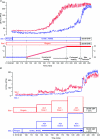
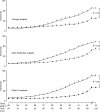
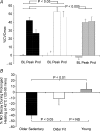
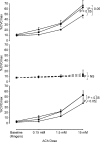
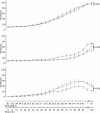
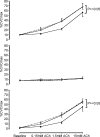
Comment in
-
Human cutaneous microvascular ageing: potential insights into underlying physiological mechanisms of endothelial function and dysfunction.J Physiol. 2008 Jul 15;586(14):3301. doi: 10.1113/jphysiol.2008.157594. J Physiol. 2008. PMID: 18625801 Free PMC article. No abstract available.
References
-
- Boegli Y, Gremion G, Golay S, Kubli S, Liaudet L, Leyvraz PF, Waeber B, Feihl F. Endurance training enhances vasodilation induced by nitric oxide in human skin. J Invest Dermatol. 2003;121:1197–1204. - PubMed
-
- Bonetti PO, Pumper GM, Higano ST, Holmes DR, Jr, Kuvin JT, Lerman A. Noninvasive identification of patients with early coronary atherosclerosis by assessment of digital reactive hyperemia. J Am College Cardiol. 2004;44:2137–2141. - PubMed
-
- Boutsiouki P, Georgiou S, Clough GF. Recovery of nitric oxide from acetylcholine-mediated vasodilatation in human skin in vivo. Microcirculation. 2004;11:249–259. - PubMed
-
- Carberry PA, Shepherd AM, Johnson JM. Resting and maximal forearm skin blood flows are reduced in hypertension. Hypertension. 1992;20:349–355. - PubMed
Publication types
MeSH terms
Substances
Grants and funding
LinkOut - more resources
Full Text Sources
Medical

